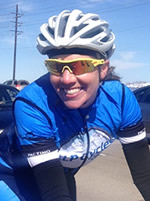Pain is complex because it is a subjective experience.
by Jennifer Sharp, ALP Cycles Coaching
Last month, Alison and I attended the TrainingPeaks Endurance Coaching Summit held at Colorado University in Boulder. The Summit brought together over 150 coaches, physiologists, businesses and thought leaders based in the field of endurance sports. During the break out sessions, attendees could choose between different lectures, depending on their interest. While there, I attended Carrie Cheadle’s The Psychology of Suffering lecture. Carrie is a certified consultant through the Association for Applied Sports Psychology and is passionate about educating others on sports psychology. The following are my observations from her talk, broken into three parts (Part 2 is below).
As mentioned in my previous post about digging into the pain cave, pain is a complex and subjective experience. By using mental skills training, you can increase your pain threshold.
Sport, and more specifically cycling, is riddled with different degrees of pain. Hill climbing, time trials, and getting pushed to your limit can create physically painful experiences. Each person is unique in how they experience pain. Below are five tools you can use to grow your pain threshold.
1. Accept the pain. Pushing your body to its limit is uncomfortable. You must embrace it. Enjoy what you’re doing and you’ll mitigate the pain. Ask yourself what it is you don’t and be objective.
2. Have a race goal. Get specific. You’re more likely to push yourself when you are at your limit if you set a goal that you can accomplish. Be sure to have both an outcome goal and a process goal.
3. Relax, relax, relax! If you’re tense, you won’t perform to your full potential. Use music, practice breathing and use mental cues to relax your mind and body.
4. Choose your focus. You can use association or disassociation. Association is when you are at your peak suffering and you can focus on technique (such as pedaling) and tune into your breathing. Disassociation happens at lower thresholds and usually longer distances. Using music or audiobooks help disassociate from what you are doing.
5. Establish an end. Tell your brain there will be a finish to what you’re doing. To do this, pick a marker along the route as an end and once you reach it, pick another end. Distract your brain one goal at a time.
In the final installment of digging into the pain cave, we’ll talk about how changing your perception of pain can affect your tolerance of pain. I’ll provide you with a few more tips on how to grow your pain threshold by practicing it in training. Having a toolset of how to deal with pain can be part of your reward.
. . . . . . . . . . . . . . . .
ABOUT JENNIFER SHARP
 Jennifer Sharp, a USA Cycling Level 1 Coach, started racing in 2004 as a means to fulfill her competitive itch. Previously a national level boxer, she grew tired of getting hit in the head and decided to pound the pedals instead. She bought a pink Kona road bike completing several recreational rides and found herself passing as many people as possible. Since then she has multiple podiums at elite track national championships, master track national championship titles and world cup finishes under her belt.
Jennifer Sharp, a USA Cycling Level 1 Coach, started racing in 2004 as a means to fulfill her competitive itch. Previously a national level boxer, she grew tired of getting hit in the head and decided to pound the pedals instead. She bought a pink Kona road bike completing several recreational rides and found herself passing as many people as possible. Since then she has multiple podiums at elite track national championships, master track national championship titles and world cup finishes under her belt.
Jennifer, a Seattle native, joins the ALP Cycles Coaching with a background in road and track. Her experience as a USA ParaCycling team tandem pilot, part-time work at USA Cycling in the Coaching Education Department and love for all things cycling is a welcomed addition to the ALP Cycles Coaching team.













